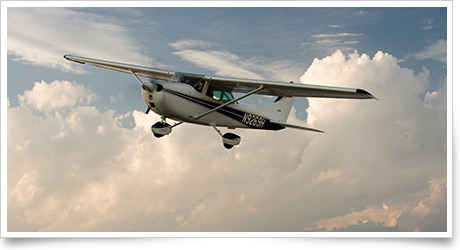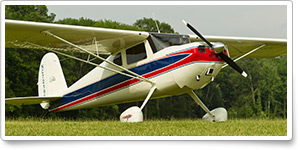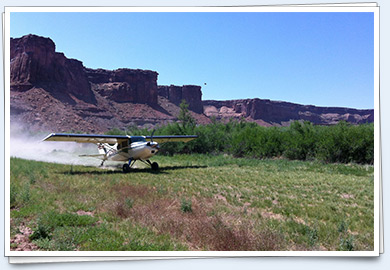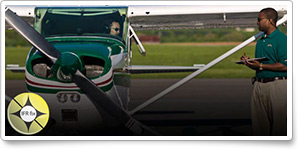| ||||||
| Trial by turbulence |
| |||||
Training TipsTrial by turbulence As you gained flight experience, it seemed less like magic. Now you are getting pretty good at it too. Looking at the forecast before a solo cross-country, you find yourself thinking, "It's going to be bumpy today." How bumpy, and where? Hard to say for certain. But experience teaches that basic rules can shape expectations. Turbulence from surface heating can be unpleasant at lower levels, but may disappear at the altitude where the columns of heated air stop rising, according to a well-known formula for approximating the height of fair-weather cumulus cloud bases. Selecting a higher-than-usual cruise altitude, or changing altitudes, may provide relief. Strong winds flowing after the passage of a cold front may or may not bear a bushel of bumps—but if surface winds blow strongly from varying directions, or are gusting, add the recommended gust factor value to takeoffs or landings. Winds aloft can create turbulence around mountain peaks or ridges, so give your cross-country destination careful study for the best routing. Give yourself plenty of clearance overflying high terrain. Be watchful for lenticular or rotor clouds that indicate severely rough air. Another turbulence tip: Get a head start on a long flight by departing early and enjoying a few hours of smooth air before solar heating goes to work on the air. (Make sure the FBO knows to have the aircraft ready.) Securing your baggage and flight gear carefully is a wise precaution. Make sure your seatbelt and shoulder harness also are well secured. Know your aircraft’s turbulence penetration speed or maneuvering speed at the appropriate loaded weight. Look for a placard displaying V A near the airspeed indicator. Flying in turbulence demands patience when you want to hurry up, and a light touch when it seems difficult to loosen your grip. Resist temptation to chase altitudes or indications of the vertical speed indicator, which would only bring on fatigue. Let other pilots know what you are encountering along the way with a pirep on the type and intensity of turbulence. If forecast turbulence was a no-show, make someone happy by sharing the good news. Flight Training NewsAmerican Flyers partners with universityAmerican Flyers and Nova Southeastern University have partnered to offer a bachelor’s degree in human services aviation with a concentration in human factors aviation. The program begins in the fall. Academic courses will be completed online and students will obtain flight training with American Flyers. Read more >> ‘Learn to Fly’ event takes 258 passengers aloftLearn to Fly Day, held June 2 at Frederick Municipal Airport, was blessed with near-perfect weather and an enthusiastic crowd. The event drew an estimated 600 people and volunteer pilots flew 258 passengers. AOPA and the airport sponsored the event. Read more >> Storm Week just around the cornerWatching a thunderstorm mature from your front porch can be beautiful. Flying anywhere in the vicinity of one can be ghastly. Combat convective weather with the Air Safety Institute and Storm Week—June 11 through 15. Each day the Air Safety Institute will launch a thunderstorm-themed product, including an Ask ATC video, a quiz, and a live webcast. Mark your calendar now for the live webcast on June 14. Renowned experts explore convective weather, ATC’s role, and when to say “no” to a flight. Tap into Storm Week and apply what you learn. Tennessee aviation legend diesEvelyn Bryan Johnson, the legendary Tennessee flight instructor and designated pilot examiner, died May 10 at the age of 102. Johnson logged 57,635.4 flight hours and administered some 9,000 practical tests. Better known by her many students as “Mama Bird,” she continued to instruct until she was 92. Read more >> Resuming the journey: More takeoffs and landingsAs AOPA staff member Kathy Dondzila presses on to regain her currency in anticipation of flying in Alaska, she discovers that getting the knack of the perfect landing is more elusive than she’d anticipated. In the latest update on her journey, Dondzila shares some tips from her flight instructors on how to improve her landings. Read more >> Training ResourcesPilots who haven’t been flying very long may feel a little intimidated when it’s time for their flight review. But with a little preparation, a flight review can be a huge confidence booster as you demonstrate how much you’ve learned since your checkride. Get a head start on preparing for your flight review with the Air Safety Institute’s Pilot Proficiency and the Flight Review Safety Spotlight. From tips on mastering landings to making sound decisions in the air, the Air Safety Institute has the resources you need to make this event just another flight.
Did you know that student pilots who join AOPA are three times more likely to complete their flight training? Membership includes unlimited access to aviation information by phone (800/USA-AOPA, weekdays from 8:30 a.m. to 6 p.m. Eastern time) or from Flight Training Online or AOPA Online. If you’re not already a member, join today and get the pilot’s edge. Login information is available online. Midair collisionsA recent midair collision involving two aircraft in Virginia has brought national attention to general aviation, but the statistics behind midairs might surprise you. In this interview with AOPA Foundation President Bruce Landsberg, you’ll learn that GA averages one midair collision nationally per month, and the trend has decreased over the last five years. And not all midairs are fatal—but 60 percent are. You’ll also learn steps you can take and resources you can utilize to help keep you out of the path of another aircraft. Watch AOPA Live® >> Career PilotAirTran launches new international serviceAirTran Airways, a subsidiary of Southwest Airlines, launched new international service May 24 between Fort Lauderdale/Hollywood, Fla., and San Juan, Puerto Rico, with two daily nonstop flights; between San Antonio, Texas, and Mexico City, Mexico, with one daily nonstop flight; and between San Antonio and Cancun, Mexico, with four weekly nonstop flights. On May 25, the carrier inaugurated service between Austin-Bergstrom International Airport in Texas and Cancun with four weekly nonstop flights. On June 3, AirTran began operating one daily nonstop flight between John Wayne Airport in Orange County, Calif., and Mexico City, and one daily nonstop between Orange County and Cabo San Lucas/San Jose del Cabo. Also beginning June 3 was a daily nonstop flight between Chicago Midway and Cancun. FAA could reconsider cargo pilot exclusion from rest rulesThe FAA said May 17 that it “discovered errors” while preparing court papers and is ready to provide the relief requested by the Independent Pilots Association, the union that represents UPS pilots—and will take another look at whether cargo pilots should be excluded from new rest rules published in December 2011, the union said. The FAA filed a motion asking the court for “an order holding this appeal in abeyance and remanding the record to the FAA to permit correction of newly discovered errors in the administrative record supporting the regulation at issue in this case as it pertains to all-cargo flight operations.” The FAA said it “discovered errors in calculating the scope of costs associated with the implementation of the regulations (rest rules) for all cargo operations.” As a result, the agency proposes to “reopen the record by issuing a supplemental regulatory evaluation strictly limited to the application of the new regulations to all-cargo operations.” The FAA action would occur on an expedited basis. Plane SpotterCessna 120-140: Compact classics Training ProductsStudy Buddy Premium FAA test prep from Sporty’sPlanning to take the FAA sport pilot knowledge test? Sporty’s has launched a premium version of its Study Buddy online study program. The premium version enables the user to create customized study sessions and take randomly generated practice tests. You can further cement your knowledge by viewing questions without answer choices—you mentally answer a question, click on the screen, and get only the correct answer. The $9.95 fee gives you a 90-day subscription. Free access to the basic Study Buddy remains available. Go online or call 800/776-7897. Note: Products listed have not been evaluated by ePilot editors unless otherwise noted. AOPA assumes no responsibility for products or services listed or for claims or actions by manufacturers or vendors. Member BenefitsSilberman, Sackier bring wit, wisdom to health and wellnessDr. Warren Silberman, who served as the manager of the FAA Aerospace Medical Certification Division in Oklahoma City, Okla., and Jonathan Sackier, AOPA’s wellness consultant who brings his own unique brand of wit to health and wellness, will be among the prominent faces of Pilot Protection Services. If you haven’t seen and heard them together, you are in for a treat! Not only will you be better informed about health and wellness issues that can affect your flying future, you’ll also be highly entertained at the same time. Read more >> New discount saves members nearly 20 percentAs a new participating company in the AOPA Lifestyles Member Discounts program, Aviation Laboratories (AvLab) is now offering AOPA members a nearly 20-percent discount off its new, trackable metal check test kits. Read more >> BlogsThe drinking pilot scenariosChip Wright posed a hypothetical situation involving a possibly intoxicated airline pilot and asked you to play his first officer. He discusses your responses, and the real-world approaches to this scenario, in the latest Flight Training blog. Are you ready to learn?Learning won’t take place until the student is ready. So even if you think you’re ready, you may not be. Are you rested? Do you feel motivated and confident? In the Let’s Go Flying blog, Pat Flannigan shares more steps you can take to ensure you get the most from each flight lesson. AOPA Career OpportunitiesEver dream of turning your passion for aviation into a career? We’re looking for a vice president of information systems; registration, housing, and meeting planner; aviation technical writer; member services representative; and enewsletter and social media editor. To learn more about other AOPA career opportunities, visit AOPA Online. Community
AVIATION EVENTS & WEATHER
| ||||||||||||||||||||||||||||||||||||




 Not long ago you thought that your flight instructor possessed uncanny skill for predicting turbulence encounters on your training flights.
Not long ago you thought that your flight instructor possessed uncanny skill for predicting turbulence encounters on your training flights.




